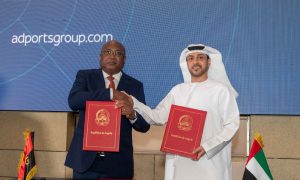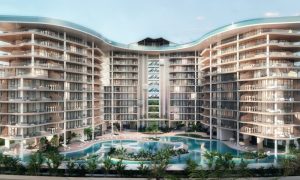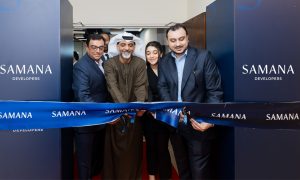Building on reputation
Ahead of its official launch this month, president of the American Institute of Architects Middle East, Thierry Paret, talks to The Big Project about industry standards and the future of architecture in the region

Since it was established more than 150 years ago, The American Institute of Architects (AIA) has opened chapters across the globe. With 80,000 members worldwide, the organisation will launch its fifth international division covering the Middle East and North Africa region, this month in Dubai.
Aiming to increase ethical and design standards, the Dubai base will also provide an educational and social outlet for American architects practising in and around the Middle East. While the new MENA chapter reaches as far afield as Tunisia and Morocco, the “main hub” will be the UAE.
“We are not here to preach to architects,” says chapter president Thierry Paret.
“We will be holding seminars where we reinforce the organisation’s values and we will also become involved in professional issues,” he says, explaining that such issues must be raised by more than one member and concerned with the code of ethics or professional conduct.
“Rightful ownership of intellectual property is probably one of the major issues that arises, but there are many others which cover all aspects of practice.
“The process is about having discourse with members of AIA Middle East. The chapter has been put in place to service American architects who are working abroad, but we also want to engage with local architects and encourage them to join.”
The chapter has been put in place to service US architects working abroad but we also want to engage with local architects joining”
Paret’s appointment in October 2010, celebrated at a dinner attended by industry professionals in Dubai, marked the establishment of the new chapter. Paret, who was elected by board members from locally practising American firms such as AECOM, Gensler, RTKL, FXFowle, KPF and SOM, will remain in the role until the end of 2011, in addition to his post as one of three lead designers at AECOM’s Architectural Design Studio in Abu Dhabi.
Commenting that the new chapter addresses a gap in the market for professional affiliation, he adds that despite working “sixty-plus hours a week”, there is “little cross pollination” between architects at different firms.
“Yes we are competitors in the market, but because we are not all specialists in every field, if we have information on some point, issue or technical aspect, we can share that for the benefit of the client.”
“There is not really a registered body for the architecture profession here; there is the Society of Engineers, but it doesn’t focus on architecture in the same way.”
The organisation’s objectives will be achieved via a series of seminars, educational workshops and social events that are open to members and non-members who are practising in the region.
Voice of a profession
You look back at something from 10 years ago and think ‘why did I do that’”
The AIA began in 1857 when 13 architects formed an organisation that had the remit to “promote the scientific and practical perfection of members” and to “elevate the standing of the profession”.
Now with five international chapters and 80,000 members globally, the group says it is the “voice of architecture in the US”.
The chapter has partnered with The American University in Sharjah to accredit its courses to the United States’ Architect Registration Board (USARB) standards. Students from the institution can transfer their qualifications, enabling them to sit the ninepoint finishing exams at the end of their threeyear apprenticeship.
In addition, the partnership will provide students in Sharjah with opportunities for firsthand experience of working design studios.
AIA ME will also strengthen its presence by collaborating on events with the Royal Institute of British Architects (RIBA).
“We are hearing a lot of positive feedback; a lot of it has been from US architects in the region. Our members create a huge pool of knowledge and skills.”
The future of design
Explaining that design itself is a process of evolution, Paret says architecture is “an old person’s profession”.
“You look back at something from 10 years ago and think ‘why did I do that’.
“As you go through you’re always looking back and thinking ‘I could have done this differently or better.’”
Despite having one eye on the past, Paret says the future of design is sustainability; but not of the ‘green’ variety.
“New buildings are being viewed more carefully by clients and architects to make them more sustainable. It’s not sustainability from the point of view of being green, but sustainability in terms of the building existing for 50 or 100 years under different functions.”
Naming Dubai’s Burj Khalifa and Rolex Tower, as well as Abu Dhabi’s Louvre and Ferrari World as his favourite examples of architecture in the UAE, Paret says the country needs to evolve “to become like London or New York” in terms of how buildings are used.
“How a building is used today may be different tomorrow. As a client you don’t know what will happen to the land and it is part of the financial strategy to think you may have to take a wrecking ball to the building.”
Adding that architects need to design with considerations beyond the immediate project, he praises the foresight of bodies such as the Abu Dhabi Urban Planning Council for integrating new projects with neighbouring buildings and environments.
Despite the wider lack of foresight when assimilating new and old buildings, Paret praises the distinctiveness of the region saying it still presents “great opportunities” for architects at all levels. “The downturn has had a positive effect because it gives us a chance to think about what we have created and the quality of our work.” Adding that boom times are “like a feeding frenzy to get the work done”, he observes: “There are still many opportunities here in the Middle East, but firms need to adapt to the new balance of work coming in.”



















